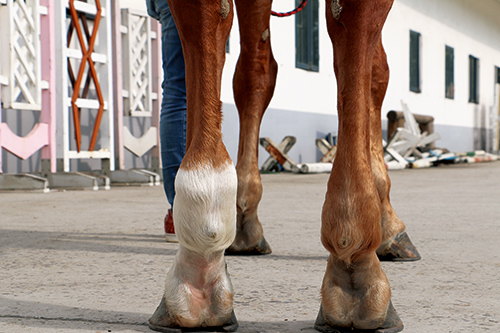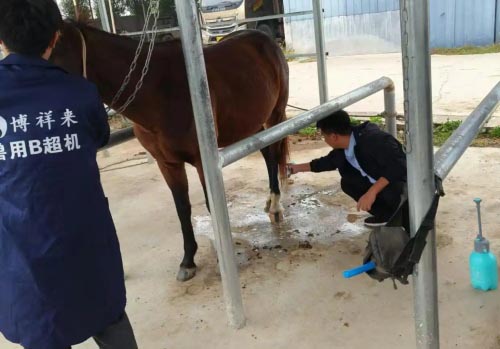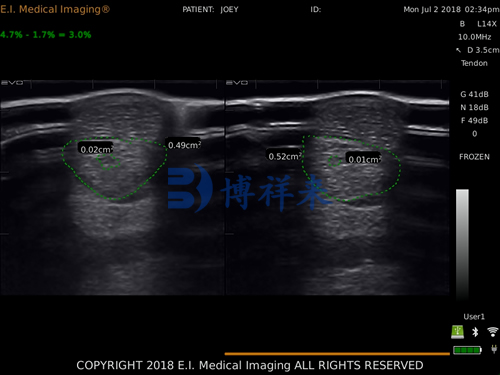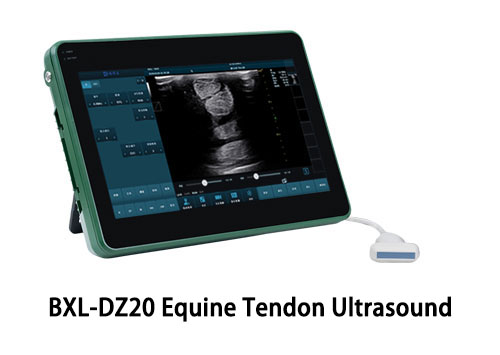Tendon injuries are among the most common and challenging musculoskeletal problems encountered in equine athletes. Whether you’re training racehorses in the United States, managing dressage horses in Germany, or caring for endurance horses in the Middle East, preventing tendon injuries is a shared concern among equestrians and veterinarians around the world. Tendons—particularly the superficial digital flexor tendon (SDFT)—are subject to intense strain during exercise, and once injured, healing is slow and prone to reinjury.

Horse skin tendons
В этой статье, we explore the causes of tendon injuries, the best global practices for prevention, and how advances in veterinary technology—like the BXL-DZ20 ultrasound device—can support ongoing tendon health monitoring.
Understanding Tendon Injuries
To prevent injury, one must understand the function and vulnerability of equine tendons. Tendons connect muscles to bones and transmit the force of muscle contraction, allowing for movement. The SDFT, Например, acts like a spring during high-speed locomotion, storing and releasing energy. Unfortunately, this high-load function makes tendons susceptible to micro-damage.
Tendon injuries generally fall into two categories:
- Acute injuries: Sudden rupture or strain during exercise.
- Chronic injuries: Accumulated microtrauma that eventually leads to clinical signs.
Veterinarians across continents emphasize that many injuries classified as “sudden” actually result from long-term degeneration and poor tendon conditioning. Therefore, prevention must be proactive and continuous.
Key Risk Factors for Tendon Injuries
Regardless of geography, most equine experts agree on the key risk factors that contribute to tendon injuries:
- Overtraining or sudden increase in workload
- Poor conformation (especially long or upright pasterns)
- Inadequate warm-up or cool-down
- Poor surface conditions (too hard or too deep)
- Improper shoeing
- Previous tendon injury
While some of these factors (like conformation) are unchangeable, many are within the handler’s or trainer’s control.

Horse skin tendon ultrasound
International Strategies for Preventing Tendon Injuries
From the American Equine Practitioners’ Association to the British Horse Society, equine care professionals share similar principles for injury prevention. Here’s how tendon health is managed globally:
- Gradual Training Progression
In nearly all countries where equestrian sports are prominent, a gradual conditioning program is considered foundational. The goal is to slowly increase the load on tendons, allowing them time to adapt. This is especially important for young horses or horses returning from injury.
In Sweden, Например, many trainers implement long slow distance (LSD) work on firm, level surfaces to condition the limbs before introducing speed work.
- Adequate Rest and Recovery
Tendons need time to repair micro-damage. High-performance stables in the U.S. and UK often use rotation training schedules to avoid repeated strain. Between intense sessions, horses are walked or turned out to encourage circulation without overloading the limbs.
- Warm-Up and Cool-Down Protocols
Warm-up routines increase blood flow and prepare the tendons for loading. In Australia and New Zealand, trainers use extended walking and trotting periods before galloping. Cooling down is equally emphasized to gradually reduce circulation and temperature, preventing sudden stiffness and swelling.
- Surface Management
Surface consistency plays a major role in tendon stress. In the Middle East, where sand arenas are common, trainers carefully manage depth to avoid overstrain. In Europe and North America, many facilities invest in arena grooming equipment and avoid working horses on overly firm ground.
- Corrective Shoeing and Hoof Balance
Veterinary farriers around the world agree: poor hoof balance contributes to uneven loading of tendons. Regular trimming, shoeing that supports the heel, and evaluation of gait are crucial in preventing unnecessary strain. This principle is taught in major equine institutions from Germany’s Warendorf School to U.S. vet schools.
- Use of Supportive Therapies
While supportive boots and wraps are widely used, their benefit is primarily protective rather than preventative. Однако, post-exercise therapies—such as cold hosing, ice boots, and massage—are commonly used across continents to reduce inflammation and promote recovery.
- Nutritional Support
Proper nutrition supports tendon health by providing the building blocks for collagen repair and maintenance. Internationally, veterinarians often recommend supplements rich in omega-3 fatty acids, Vitamin C, manganese, and glycosaminoglycans (GAGs). In Japan, where integrative care is growing, tendon health is sometimes supported with traditional herbal formulations as well.

Horse skin tendon ultrasound image
The Role of Regular Monitoring
Despite all preventive efforts, subtle tendon damage can still occur—and early detection is key. That’s why regular monitoring has become a cornerstone of modern equine management.
In elite stables across Europe and the U.S., routine ultrasound scanning is part of preventive care, even in the absence of clinical signs. Catching a lesion before it becomes symptomatic can prevent a long lay-up or catastrophic injury.
Portable devices like the BXL-DZ20 have revolutionized this process by making high-resolution tendon scans available stall-side. This allows veterinarians to:
- Assess changes in tendon echogenicity
- Monitor fiber alignment
- Detect early signs of inflammation
- Track healing progression in post-injury rehabilitation
How Technology Enhances Prevention: BXL-DZ20 in Action
BXL, a professional manufacturer of veterinary ultrasound systems, has developed the BXL-DZ20 to meet the needs of equine professionals worldwide. This compact, user-friendly device allows for:
- Immediate scanning in the stable, paddock, or field
- High-resolution images of superficial and deep flexor tendons
- Wireless transmission for remote expert consultation
- Easy integration with patient record systems
In a preventative care program, the BXL-DZ20 can be used to:
- Establish a baseline for each horse’s tendon structure
- Perform routine check-ups every few weeks during high-load training phases
- Evaluate any subtle swelling or gait changes before they escalate
This type of real-time, on-demand scanning aligns with the global movement toward proactive and personalized veterinary care.

БСЛ-ДЗ20 Mud skin tendon ultrasonic wave
Case Example: Proactive Monitoring Saves a Season
A show jumping stable in the Netherlands implemented monthly tendon scans with the BXL-DZ20 for all competition horses. In one instance, a scan revealed a small hypoechoic lesion in the left forelimb SDFT of a 9-year-old warmblood, though the horse was still sound. The veterinary team adjusted the training program, implemented controlled exercise, and avoided a full-blown tendon tear. The horse returned to full competition three months later—something that would have been impossible had the injury progressed unnoticed.
Заключение: Prevention is a Partnership
Tendon injury prevention in horses is not a single technique—it’s a system. It involves careful training, attentive husbandry, experienced veterinary input, and increasingly, the power of modern technology. Around the world, equine professionals agree that tendons don’t just “break”—they are worn down over time, and proper care can prevent that breakdown.
At BXL, we’re proud to support this global standard of care. As a professional provider of veterinary ultrasound systems, we’ve developed the BXL-DZ20 to make tendon monitoring easier, faster, and more accessible. Whether you’re an equine vet, trainer, or owner, having the ability to regularly assess tendon health gives you the power to prevent injury before it happens.
After all, a sound horse is a successful horse—and prevention is the best medicine.